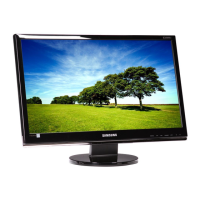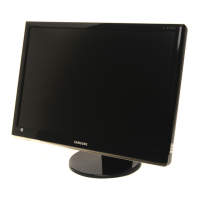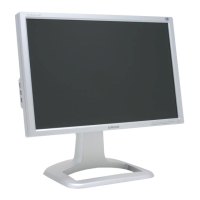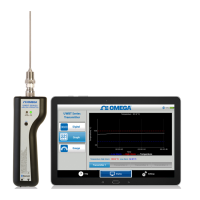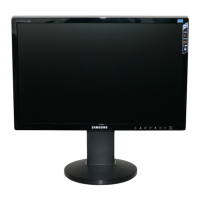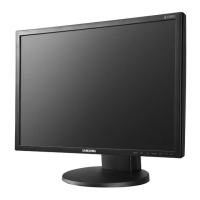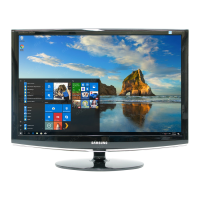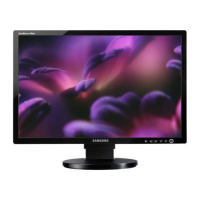Do you have a question about the Samsung SyncMaster 2494HS and is the answer not in the manual?
Explains safety symbols and conventions used in the manual for clear understanding.
Provides critical safety instructions related to powering the monitor and its connections.
Details safety measures for installing the monitor, including handling and placement.
Provides safe methods for cleaning the monitor case and screen to prevent damage.
Covers various safety warnings and general precautions for product use.
Guides users on maintaining correct posture for comfortable and safe monitor usage.
Lists included items and illustrates different monitor stand types.
Identifies all included and optional parts for the monitor setup.
Guides through initial setup, including language and resolution settings.
Identifies and explains the function of buttons on the front of the monitor.
Details the various ports and connectors located on the rear of the monitor.
Instructions on how to use the Kensington lock for physical security.
Illustrates how to connect the monitor using D-sub, DVI, and audio cables.
Step-by-step guides for connecting via HDMI and DVI-to-HDMI cables.
Instructions for connecting USB devices to the monitor's ports.
Guidance on connecting headphones to the monitor's audio output.
Instructions for assembling and attaching the monitor stand.
Details on HAS/USB stands and how to swivel the monitor.
Instructions for adjusting the tilt angle for different stand types.
Information on VESA mounting interface and attaching stands.
Step-by-step guide for attaching the simple and HAS monitor stands.
Information and procedures for installing the monitor driver software.
Steps for automatically installing the monitor driver.
Detailed steps for manually installing the driver on various Windows versions.
Information on the Natural Color software for color management.
Guides on how to install and uninstall the Natural Color software.
Instructions for installing and using the AutoRotation software.
Procedure for uninstalling AutoRotation and MultiScreen software.
Instructions for installing and using the MultiScreen software.
Overview of direct functions and using the AUTO button for picture adjustment.
How to lock and unlock the On-Screen Display (OSD) menu.
How to customize the function assigned to the monitor's custom key.
Adjusting audio volume and selecting the video input source.
Adjusting basic picture settings like brightness and contrast.
Explains the MagicBright feature and its pre-configured viewing modes.
How to select different picture modes for optimal viewing experience.
Guides on adjusting color settings like MagicColor and Color Tone.
Adjusting color balance, color tone, and applying color effects.
Explains Gamma correction for adjusting luminance and color.
Adjusting image parameters such as Coarse, Fine, and Sharpness.
Adjusting horizontal/vertical display position and OSD menu layout.
Setting OSD language and adjusting the transparency of the OSD background.
Configuring OSD display time and resetting settings to factory defaults.
Setting the auto power-off timer and selecting signal sources automatically.
Adjusting screen image size and selecting HDMI/DVI modes.
Optimizing display for AV devices and adjusting HDMI black level.
Shows video source and display mode information on the OSD screen.
Procedure to perform a self-test to verify monitor functionality.
Explains common warning messages and their meanings.
Discusses how environmental factors can affect monitor quality.
Provides useful tips and a checklist for diagnosing common monitor problems.
Troubleshoots issues related to the MagicTune software not functioning.
Instructions for cleaning the monitor's outer case and LCD panel.
Provides general details, LCD panel size, synchronization, and resolution specs.
Details VESA mounting, environmental conditions, and Plug & Play capability.
Information on PowerSaver feature and acceptable pixel variations.
Lists preset display modes with horizontal/vertical frequencies and pixel clock.
Tips for adjusting computer settings to achieve the best picture quality.
Explains image retention and provides methods to prevent it.
Specific advice for preventing image retention in various applications.
Contact details and websites for Samsung customer support worldwide.
Defines technical terms related to monitor display and performance.
Instructions for correct product disposal and legal notices.
Explains safety symbols and conventions used in the manual for clear understanding.
Provides critical safety instructions related to powering the monitor and its connections.
Details safety measures for installing the monitor, including handling and placement.
Provides safe methods for cleaning the monitor case and screen to prevent damage.
Covers various safety warnings and general precautions for product use.
Guides users on maintaining correct posture for comfortable and safe monitor usage.
Lists included items and illustrates different monitor stand types.
Identifies all included and optional parts for the monitor setup.
Guides through initial setup, including language and resolution settings.
Identifies and explains the function of buttons on the front of the monitor.
Details the various ports and connectors located on the rear of the monitor.
Instructions on how to use the Kensington lock for physical security.
Illustrates how to connect the monitor using D-sub, DVI, and audio cables.
Step-by-step guides for connecting via HDMI and DVI-to-HDMI cables.
Instructions for connecting USB devices to the monitor's ports.
Guidance on connecting headphones to the monitor's audio output.
Instructions for assembling and attaching the monitor stand.
Details on HAS/USB stands and how to swivel the monitor.
Instructions for adjusting the tilt angle for different stand types.
Information on VESA mounting interface and attaching stands.
Step-by-step guide for attaching the simple and HAS monitor stands.
Information and procedures for installing the monitor driver software.
Steps for automatically installing the monitor driver.
Detailed steps for manually installing the driver on various Windows versions.
Information on the Natural Color software for color management.
Guides on how to install and uninstall the Natural Color software.
Instructions for installing and using the AutoRotation software.
Procedure for uninstalling AutoRotation and MultiScreen software.
Instructions for installing and using the MultiScreen software.
Overview of direct functions and using the AUTO button for picture adjustment.
How to lock and unlock the On-Screen Display (OSD) menu.
How to customize the function assigned to the monitor's custom key.
Adjusting audio volume and selecting the video input source.
Adjusting basic picture settings like brightness and contrast.
Explains the MagicBright feature and its pre-configured viewing modes.
How to select different picture modes for optimal viewing experience.
Guides on adjusting color settings like MagicColor and Color Tone.
Adjusting color balance, color tone, and applying color effects.
Explains Gamma correction for adjusting luminance and color.
Adjusting image parameters such as Coarse, Fine, and Sharpness.
Adjusting horizontal/vertical display position and OSD menu layout.
Setting OSD language and adjusting the transparency of the OSD background.
Configuring OSD display time and resetting settings to factory defaults.
Setting the auto power-off timer and selecting signal sources automatically.
Adjusting screen image size and selecting HDMI/DVI modes.
Optimizing display for AV devices and adjusting HDMI black level.
Shows video source and display mode information on the OSD screen.
Procedure to perform a self-test to verify monitor functionality.
Explains common warning messages and their meanings.
Discusses how environmental factors can affect monitor quality.
Provides useful tips and a checklist for diagnosing common monitor problems.
Troubleshoots issues related to the MagicTune software not functioning.
Instructions for cleaning the monitor's outer case and LCD panel.
Provides general details, LCD panel size, synchronization, and resolution specs.
Details VESA mounting, environmental conditions, and Plug & Play capability.
Information on PowerSaver feature and acceptable pixel variations.
Lists preset display modes with horizontal/vertical frequencies and pixel clock.
Tips for adjusting computer settings to achieve the best picture quality.
Explains image retention and provides methods to prevent it.
Specific advice for preventing image retention in various applications.
Contact details and websites for Samsung customer support worldwide.
Defines technical terms related to monitor display and performance.
Instructions for correct product disposal and legal notices.
| Pixel pitch | 0.272 x 0.272 mm |
|---|---|
| Aspect ratio | 16:9 |
| Display diagonal | 24 \ |
| Vertical scan range | 50 - 85 Hz |
| Horizontal scan range | 30 - 81 kHz |
| Viewing angle, vertical | 160 ° |
| Contrast ratio (dynamic) | 50000:1 |
| Contrast ratio (typical) | 1000:1 |
| Viewing angle, horizontal | 170 ° |
| Display brightness (typical) | 300 cd/m² |
| HDCP | Yes |
| RMS rated power | 3 W |
| Certification | ISO 13406/2 TCO '03 CE |
| Product color | Black |
| Market positioning | - |
| Compliance industry standards | DDC 2B |
| Panel mounting interface | 200 x 100 mm |
| Power consumption (standby) | 1.5 W |
| Power consumption (typical) | 48 W |
| Sustainability certificates | ENERGY STAR |
| Depth (with stand) | 227.4 mm |
|---|---|
| Width (with stand) | 572.8 mm |
| Height (with stand) | 420.4 mm |
| Weight (with stand) | 6200 g |
| Depth (without stand) | 67.5 mm |
| Height (without stand) | 363.7 mm |
